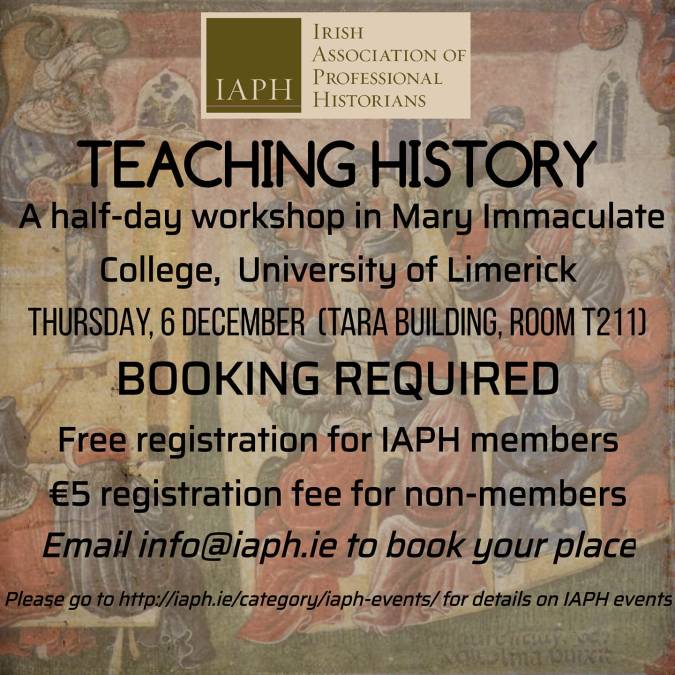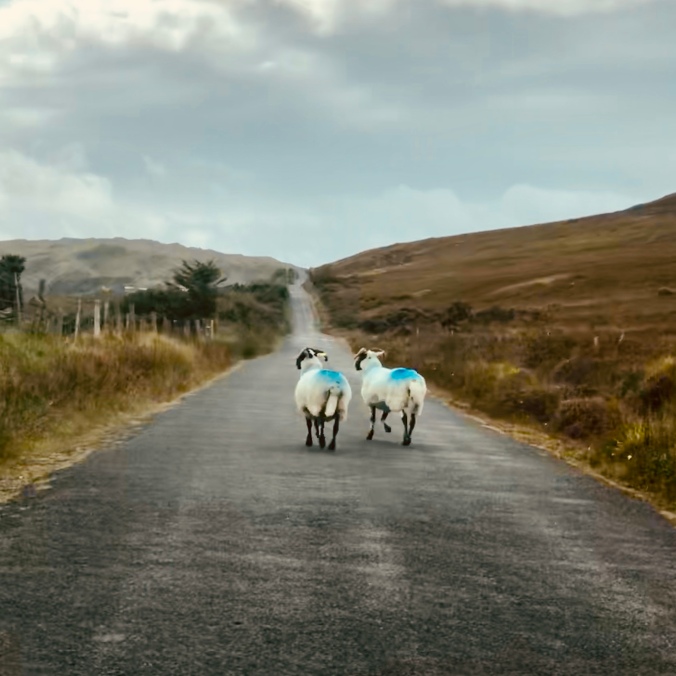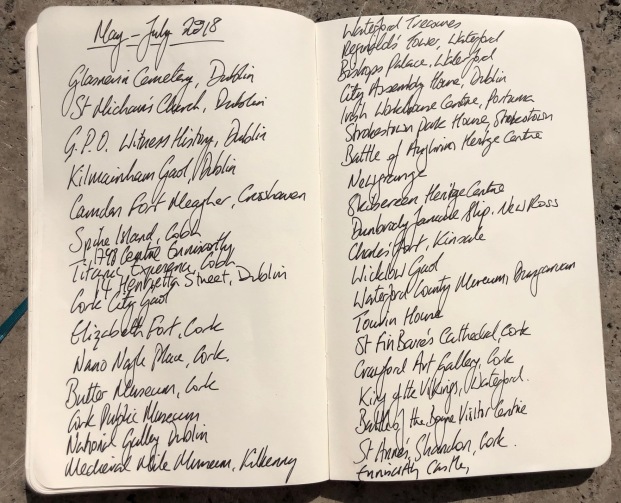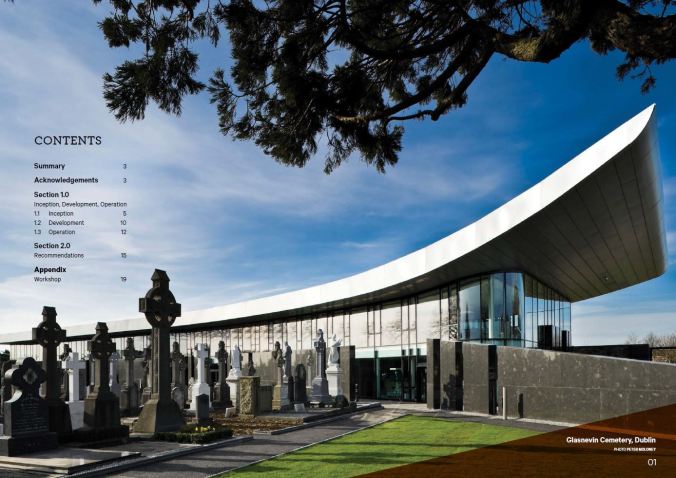 I’m delighted to be speaking at the Irish Association of Professional Historian’s ‘Teaching History’ Workshop which will be held at Mary Immaculate College, Limerick on 6 December 2018. Continue reading
I’m delighted to be speaking at the Irish Association of Professional Historian’s ‘Teaching History’ Workshop which will be held at Mary Immaculate College, Limerick on 6 December 2018. Continue reading
Museums
A Toilet Trip: Courthouse, Cells, Coffee, Toilets!

St Albans Town Hall, c.1911
I visited St Albans in Hertfordshire this week. It’s a very attractive small city with a superb Cathedral. I did a very quick run around the Cathedral, but the real purpose of my trip was to visit some toilets. Continue reading
Talks & Travels

Taking the slow and very scenic road from Doagh Famine Village to Fort Dunree, Donegal
I’ve been busy visiting Dark Tourism sites, teaching and talking about convents & nuns at conferences so haven’t had time to blog recently…but I’ve seen lots of great sites in Sligo, Donegal, Derry & Tyrone and I will get round to writing something about them soon. I’m back on the road again in a couple of weeks so if anyone has suggestions for Dark Tourism places in Tipperary, Westmeath, Kilkenny & Limerick do let me know either here or via twitter (@gillianmobrien) or instagram (gillianmobrien) or email (g.p.obrien@ljmu.ac.uk). Continue reading
Dark Tourism – Sligo Gaol

In early September I spoke at the ‘Crime and Punishment in 19th & 20th Century Ireland’ Conference which had been organised by The Friends of Sligo Gaol to mark the bi-centenary of the prison. The conference was great – it’s rare that I go to a conference where I want to hear all the papers. The location of the conference was fitting in some ways – formerly St Columba’s asylum, now a hotel. Not content with hosting a conference the Friends of Sligo Gaol also launched a beautifully illustrated children’s book about a child prisoner and commissioned a painting of Michael Collins, the jail’s most famous prisoner. And they had themed buns! Continue reading
The famine in cheery technicolour
Yesterday a number of presidential hopefuls gave presentations to Kildare County Council in the hopes of securing a nomination to help them on their way to Áras an Uachtaráin. Among them was the artist Kevin Sharkey.
Today’s Irish Times reports that among other things Sharkey ‘criticised how motorways have cut off small rural towns and suggested opening Famine villages to draw tourists. All villages should have a girl with red hair playing a harp in the corner, someone cooking cabbage or someone burying someone outside like they used to do in the old days, he said. “This is a gold nugget that we are sitting on.”’
A whole set of Famine Villages would certainly expand my Dark Tourism trip around Ireland. While it’s amusing to imagine the Ireland of the 1840s being full of red-haired, harp-plucking, cabbage-eating colleens busy burying their dead, it’s also disappointing to think that someone who wants to become the representative of the Irish people has such a limited grasp of Irish history. Continue reading
Conferences – Convents & Gaols
During September I get to talk about two of my current research projects – Dark Tourism & Convent Architecture.
On 29 September I’ll be back at a former workplace and to speak at a conference in St Patrick’s, Dublin City University to mark the 300th anniversary of the birth of Nano Nagle the founder of the Presentation Sisters. The conference examines Nagle’s life and legacy in the context of Cork and Ireland during the era of the Penal Laws, and focuses on her pioneering contribution to female religious life and education, her spirituality, her business acumen and ambitious building plan. I’ll be talking about Nano Nagle as builder and businesswoman and there are also talks about 18th century Cork, the Penal era, history of education and religious life. The conference costs €10 and can be booked here: Nano 300


Never work with Animals or Children, they say…

Meeting me on my travels should come with some sort health and safety warning. There’s a distinct possibility that you might be dragged out on a skite to visit a site – as darkness falls after dinner and a couple of glasses of wine it is dangerous to mention that there’s a dolmen just out the road and sure we’d make it before dark to have a look. I will insist upon it! In the gloaming it was a wonder neither of us were garroted by barbed wire or carried out with a broken ankle! Also, it’s probably best not to meet me for breakfast as I’m likely to abandon the coffee shop for a quick wander around the local graveyard. That seems to me like a perfectly sensible thing to do after tea and toast.
Since the middle of May I have visited 36 museums and heritage sites as part of my Grand Tour of Ireland (and that doesn’t include the late night foray to see a Dolmen in Roscommon, or the early morning traipse around a graveyard in Athlone.) I’ve been to forts, prisons, stately homes, tenements, cemeteries, workhouses, military barracks and more. It’s been informative and really enjoyable. I’ve met all sorts of fascinating folk on my travels (of which more anon) and had some excellent travelling companions.
They say never work with animals or children. So far I haven’t taken any animals with me, but I have taken children and teenagers on some of my visits. I’m interested in seeing what interests them at sites that deal with difficult and, at times, upsetting, stories. I was a little wary about borrowing children to use as my research assistants (I didn’t take any kids I don’t already know, but still I thought there might be a lot of long drives full of grumpy silences…I was wrong. They were brilliant, insightful and entertaining).

The visits I made with the kids were the best ones. They spot things that would have gone unnoticed by me. They’re bored by a lot of the things I found fascinating. They were curious and in many cases had questions that weren’t answered by the panel text or the audio or visuals (some of the questions I could answer…occasionally it’s useful to go around Irish historical sites with an Irish historian. Other times I suspect it’s a bore. I tried to limit my ‘Did you know….’ stories!)
It was no surprise that they enjoyed being active rather than passive. They don’t need everything to be interpreted – sometimes it’s enough to be allowed roam around a site (though a little more interpretation at Charles Fort in Kinsale wouldn’t go amiss). Sneaking about, staring at walls trying to find some old graffiti that hasn’t been spotted before, disappearing down tunnels and playing with creaky doors are some of the great joys of visiting old sites. Being able to go inside a cell and close the door, being allowed walk around the prison yard, (this was possible in Wicklow Gaol, but not in Cork City Gaol…and we’d really liked to have been able to do that there), seeing the dormitories in a workhouse were all moving and visceral experiences. Being told that a family of 8 needed to eat 25 kilos of potatoes a day is pretty abstract, but being able to pick up a sack that weighs 25 kilos is much more tangible. Knowing that up to 300 steerage passengers were crammed below decks in the Dunbrody famine ship for weeks at a time is one thing, sitting in the hold of the full-sized replica gives a real sense of just how awful that experience was.
Through August and September I’ll be visiting another 30 sites (and I suspect that number will grow as I get recommendations along the way – having long been sceptical of Twitter it has been the source of many excellent recommendations and has brought me to places I would never have thought of visiting.) I have visited or am visiting heritage centres or museums in every county except Down, Armagh, Fermanagh, Mayo, Longford, Kildare and Clare. If I’ve missed out on any ‘Dark Tourism’ museums in those counties let me know.
I’ll also be adding to the #ReshootingJohnHinde map as I go. The map that Ronan O’Driscoll is kindly updating can be seen here: #ReshootingJohnHinde and if anyone wants to get involved in adding to the map then just follow the instructions here
Dark Tourism on RTE Radio 1

Last Friday I spoke to Ryan Tubridy about Dark Tourism and my plans to spend the summer travelling around Ireland visiting sites associated with suffering, misery and death. I hadn’t banked on the weather being glorious, which makes chasing shadows both necessary and incongruous!
I really enjoyed the chat with Ryan where I got to talk about my grandmother’s love of death (!), lots of amazing sites, my attempts to make the journey more cheerful by trying to recreate John Hinde postcards with images of today and having William Makepeace Thackeray, Frank O’Connor and others as my aged guides around the country.
You can listen back to the interview here: Dark Tourism RTE Radio 1
I have a long list of places to visit. Phase 1 of this project involves visiting sites that have a museum or heritage site or interpretative centre associated with them, but if you know of others please contact me so I can add them to my list.
This is what my map currently looks like:

Phase 2 will include tours – be they walking, driving, sailing, flying…..
Phase 3 will include memorials (and anything else I’ve missed)
I won’t be doing Phases 2 & 3 this summer (unless I work out how to clone myself), but feel free to add to my list so that I can investigate them in the future.
Next week I take on Cork, Kerry, Galway and Roscommon!
Finally, the John Hinde Postcard project is very much a communal effort so if you want to help us cover the country please join in. You can read here about how to do that here: #ReshootingJohnHinde
Contact me on Twitter: @gillianmobrien or by email: g.p.obrien@ljmu.ac.uk
Inception, Development, Operation – Museums & Heritage Centres

For some years now I’ve been working as historical adviser on a number of new site-specific museums, while also teaching and writing about them. One of the things that’s struck me most forcefully during this time is the absence of any best practice guidelines for professionals working in this area. Time and again, the teams assembled to deliver these projects find themselves obliged to develop their own protocols and procedures as they go, drawing on their own experience and expertise. While this has often produced good results, it is an arduous, time-consuming (and often costly) process and, once the site has opened and the team has dispersed, the collective knowledge pool developed over the course of the project is lost. I’ve come to feel strongly that professionals looking to develop a new museum or heritage site would benefit greatly from a set of guidelines that draws on the expertise of their colleagues and peers, and so, for the last six months, I’ve been working on a report on that will, I hope, take a first step in that direction.
The objective of the report, ‘Inception, Development and Operation’, is to offer guidance, across a wide range of issues, to individuals or groups in the process of establishing a site-specific museum or heritage site, as well as to those developing and running them. While I hope that every site-specific museum and heritage centre will find something useful in it which they can use to inform and guide their decisions, the report is intended, above all, to help groups that are considering developing sites to avoid many of the associated pitfalls. A copy of the report can be downloaded here: O’Brien – Inception Development Operation – Site-Specific Museums – 2018
The report came about largely as a result of conversations I’ve had along the way with a range of people about the challenges of developing site-specific museums and heritage sites. One of the key challenges is that these sites are one-off developments and the teams assembled to plan, develop and operate them disperse when the project is complete. Valuable lessons may be learned during the process, but this information is not passed on to others who are developing their own sites. As a result, there is a lack of residual or ‘institutional’ memory regarding best practice. This report attempts to address that problem.
The immediate genesis for this report was a workshop I organised to discuss ‘best practice for site-specific museums and heritage sites’ which was attended by a number of heritage and museum professionals. The workshop identified the key challenges faced by these sites and suggested ways in which they could be overcome. Following the workshop I had further discussions with a number of other experts working in related fields and the report draws on both those conversations and the workshop itself.
The museum and heritage sector is a growing one in terms of the number of sites for tourists and visitors to visit, but it is also one that has seen serious financial cutbacks in recent years. These projects are always expensive and it’s vital that the money is spent in areas where it is most needed. This report draws on the experience of a diverse range of experts to offer practical strategies for new museum and heritage sites, whatever their level of resources.
Although the content of this report is informed (for the most part) by experiences of developing sites in Ireland, most of the issues and challenges it addresses are not specific to this country, and I believe the report will prove useful to those working on site-specific museums and heritage sites elsewhere in Europe and beyond. However, it is not intended to be definitive. As in any other field, establishing best practice in site-specific museum and heritage sites is a work in progress. If you have any feedback on the report I would be delighted to hear from you. You can email me at g.p.obrien@ljmu.ac.uk

Sake Dean Mahomet – the ‘Irish Indian’

Sake Dean Mahomed (Thomas Mann Baynes, 1820s, Wellcome Library)
In 2018 the Walker Art Gallery in Liverpool hosted the the excellent Slaves of Fashion exhibition by the Singh Twins. The exhibition was about Empire, Britain’s relationship with India and consumerism in the past and present.
Most of the artworks on display were mixed media, combining painting with digitally created imagery. The main artworks are eleven symbolic portraits of historical figures which are displayed on lightboxes. Each artwork is beautifully detailed and reflects complex stories. I was particularly struck when I came to ‘Threads of Change’. It examines the rise of Manchester and Liverpool as centres for textile manufacture and trade. At the bottom of the artwork you can see the Liverpool skyline and some Confederate flags fluttering in the breeze – a nod to the cotton trade that had come from the Southern States in America. I was surprised to see Sake Dean Mahomet (often Mahomed) in the top left corner of this artwork. According to the Singh Twins he was included as he represented a ‘more positive legacy of Anglo-Trade relations’
I first came across Dean Mahomet at the Between Worlds exhibition held at the National Portrait Gallery in London in 2007 and more recently when, doing some research on late 18th century Cork, I found a copy of his book The Travels of Dean Mahomet in the archives of the Ursuline Sisters. I’ve been meaning to write an article about him ever since.
Mahomet had a remarkable life: ensign in the Thirtieth Sepoy Regiment in India, Protestant ‘Irish Indian’, inventor of the curry house and ‘Shampooing Surgeon’ to the kings of England.
Sake Dean Mahomet was born in Patna, a city built along the banks of the Ganges in northeast India, in 1759. Aged 11 he became camp follower at the East Indian Company’s Army which was stationed in Bengal and he was assigned to Godfrey Evan Baker a Protestant Anglo-Irish Officer. When Baker returned to Ireland in 1782 Mahomet came with him and settled in Cork in 1784. It seems he lived with the Bakers in Fortwilliam House in Tivoli (now part of the Silversprings Hotel complex). During his time in the city Mahomet became known as the ‘Irish Indian’. Two years after his arrival in Cork Mahomet caused a furore when he eloped with a young Protestant woman, Jane Daly (by this stage it seems he had abandoned his Muslim faith and become a member of the Church of Ireland).

Jane Daly
In 1793 Mahomet took out a series of advertisements in newspapers seeking subscribers for his book The Travels of Dean Mahomet. He garnered remarkable support with 320 subscribers (including Thomas Addis Emmet (the United Irishman) and Rev Dr Moylan, the Catholic Bishop of Cork). The book is the first English language book written about India by an Indian. It’s written as a series of letters about his experiences travelling across India and paints an affectionate portrait of the country and its people.
In 1807 Mahomet left Cork and headed for London where he embarked on several new careers. He initially worked as a traditional medical practitioner for Basil Cochrane a rich Scotsman in London but, after three years, he changed tack and opened the ‘Hindoostane Coffee House’. Despite its name it was not a coffee house, rather it was one of the first curry restaurants in Britain. Not only did he serve food in the restaurant, there was a delivery service for ‘such ladies and gentlemen as may be desirous of having Indian Dinners dressed and sent to their own houses’ (The Morning Post, 2 Feb 1810).
He was a man ahead of his time, or certainly ahead of British palates. The restaurant failed and Mahomet filed for bankruptcy in 1812. The Mahomet family moved to Brighton, a fashionable seaside spa town which offered great opportunities for entrepreneurs and Mahomet re-invented himself as a medical expert specialising in exotic remedies alongside selling ‘Indian tooth powder’ and hair dye. The business proved a great success and attracted the fashionable elite of Brighton and London.

Mahomed’s Baths, 1826 (W. Fleet, British Library)
In 1820 he built ‘Mahomed’s Baths’ near the Brighton Pavilion which offered therapeutic baths to invalids, and ‘Shampooing with Indian oils’. Shampooing was not as we know it today. Mahomet’s son, Horatio, later explained that shampooing consisted of ‘friction and extension of the ligaments…commencing by briskly administering gentle friction gradually increasing the pressure along the whole course of the muscles with both hands…’ More massage than hair cleaning. ‘Mahomed’s Baths’ attracted celebrity clientele and his crowning achievement was his appointment as ‘Shampooing Surgeon’ to Kings George IV and William IV. In 1820 he published Cases Cured, a far cry from his Travels book. Cases Cured was on the medical benefits of shampooing and extolled the virtues of the ‘Indian Medicated Vapour’ which he claimed to have invented.
By the 1840s Mahomet’s baths had fallen out of favour. His partner in the business had died and Mahomet didn’t have the capital to buy the enterprise outright. For the next decade the Mahomets continued their business in reduced circumstances and ever smaller premises. By the time Dean Mahomet died in 1851 the family’s fortune had disappeared and Mahomet became a footnote in the history of Indian entrepreneurs in Britain (and disappeared almost entirely from all histories of Cork, or eighteenth-century Ireland). But as the Slaves of Fashion exhibition demonstrates he hasn’t been entirely forgotten. The Singh Twins noted that the exhibition engages with “issues around shared heritage and identity which challenge generally accepted notions of cultural ownership and the perceived divide between East and West and past and present”. Dean Mahomet certainly knew about shared heritage and identity as he navigated the complex worlds of eighteenth and nineteenth century India, Ireland and England.

Sake Dean Mahomed,(Jean Pierre Feulard, Royal Pavilion, Libraries and Museums, Brighton & Hove)
Further Reading: Between Worlds. Voyagers to Britain 1700-1850 (20070
Michael Fisher (ed with introduction), The Travels of Dean Mahomet, (1997)












